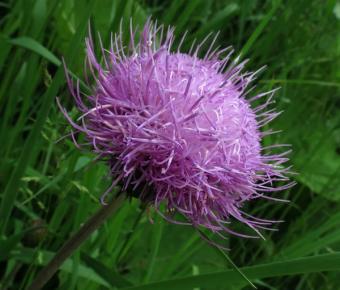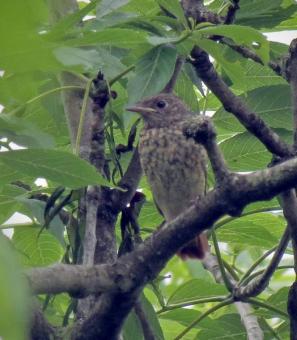 Melancholy Thistle Today's visit took us from Buckden, up the foothills of the Pike, across the river to Cray and then a return route via Cray Gill, Hubberholme and back to Buckden along the river.
Melancholy Thistle Today's visit took us from Buckden, up the foothills of the Pike, across the river to Cray and then a return route via Cray Gill, Hubberholme and back to Buckden along the river.Yet again we had some minibus troubles at the start of the day so arrival at Buckden was slightly later than planned. We had a lunch date at the farm at Cray so Joan decided to only make a mental note of the plants to speed up our progress up Buckden Rake. Once at home her list amounted to 168 species, 129 of which were in flower.This not only indicates the floral pleasures of the day but Joan's mental agility to recall so many!
Some of the most numerous species we saw included Common Rock Rose, Pignut and Yellow Rattle. In the farmyard at Cray there was a wet flush with a lovely display of Northern Marsh Orchid and Ragged Robin, and descending the gill we saw our first Common Spotted Orchids of the day. The most inconspicuous species we recorded was Marsh Arrowgrass, and we were pleased to see the beautiful Melancholy Thistle opening on the river side as we neared the end of the walk.
 Young RedstartThe most numerous birds were probably Chaffinch and the Pied and Grey wagtails. We saw fledging Redstart on the Rake, and caught a glimpse of a Pied Flycatcher near Hubberholme. Other species included Greater Spotted Woodpecker in the Buckden car park, Willow Warbler and Blackcap, and plenty of Swallows and House Martins.
Young RedstartThe most numerous birds were probably Chaffinch and the Pied and Grey wagtails. We saw fledging Redstart on the Rake, and caught a glimpse of a Pied Flycatcher near Hubberholme. Other species included Greater Spotted Woodpecker in the Buckden car park, Willow Warbler and Blackcap, and plenty of Swallows and House Martins.
We had a couple of scheduled stops on route. First a glimpse at the dry stone wall that the BEES Friday volunteers have been repairing over several weekend residentials (we didn't have time to examine them closely, but you can look at the photos in the Buckden residential galleries).
 Bees Wall With Farm In The DistanceThen, once safely over the stepping stones, we had our lunch in the farmyard at Cray, listening to Chris Akrigg who has been the tenant farmer here for over 30 years. His priorities for farming are 1) environment 2) sheep 3) cattle. 80% of the farm is governed by a Higher Level Stewardship agreement with Natural England, a bespoke management plan for this farm.
Bees Wall With Farm In The DistanceThen, once safely over the stepping stones, we had our lunch in the farmyard at Cray, listening to Chris Akrigg who has been the tenant farmer here for over 30 years. His priorities for farming are 1) environment 2) sheep 3) cattle. 80% of the farm is governed by a Higher Level Stewardship agreement with Natural England, a bespoke management plan for this farm.
Of note are the good numbers of breeding Redshank, Lapwing and Oystercatchers. This time of year sounds the worst for the sheep, with risks of disease. Chris explained that the low grazing density results in higher numbers of triplet lambs. We met some of them that been hand reared. Most of the sheep are Swaledales but they do have a few Blue Faced Leicesters. These produce a lovely knitting wool, but I realise now why it is expensive; Chris explained that once born their only ambition is to die! These sheep are valley dwellers rather suited to being left on the moor tops.
Look at the photos from today here.
Julia
